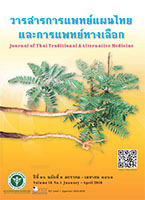Effect of Storage Times on the Syringin Content in Tinospora crispa (L.) Miers ex Hook.f. & Thomson Decoction
Main Article Content
Abstract
Antidiabetic herbal decoction with bora-phet vine or Tinospora crispa as a major component is used at Sakon Nakhon Thai Traditional Medicine (Luang Pu Fab Supatto) Hospital as bora-phet vine has syringin as an active ingredient for blood sugar reduction. In practice, boiling the preparation every day may cause inconvenience and will lead to noncompliance of the patients. This study’s objective was to investigate the stability of Tinospora crispa extract in ready-to-drink formulation by measuring the amount of syringin. Methodology: T. crispa was boiled in water for 15 minutes and then the TLC and TLC densitometer were used to determine the amounts of syringin under 5 storage times of 0, 1, 24, 72 and 120 hours at 4๐C. Results: The proportions of syringin under storage time at 0, 1, 24, 72 and 120 hr were 1.35±0.01, 1.35±0.02, 1.36±0.02, 1.27±0.03 and 1.24±0.01 percent, respectively. The amount of syringin bora-phet vine reduced significantly after 72 hours or more of storage. It is thus concluded that bora-phet concoction with storage time of 3 days or more results in a drop in syringin content.
Article Details
References
2. Al-Alusi NT, Kadir FA, Ismail S, Abdullah MA. In vitro interaction of combined plants: Tinospora crispa and Swietenia mahagoni against methicillin-resistant Staphylococcus aureus (MRSA). African Journal of Microbiology Research. 2010;4(21):2309-12.
3. Ahmad W, Jantan I, BukhariNA., Tinospora crispa (L.) Hook. f. & Thomson: a review of its ethnobotanical, phytochemical and pharmacological aspects. Frontiers in Pharmacology. 2016;7(59).
4. Noor H, Ashcroft SJ. Antidiabetic effects of Tinospora crispa in rats. Journal of Ethnopharmacology. 1989;27(1-2):149-61.
5. Noor H, Ashcroft SJ. Pharmacological characterisation of the antihyperglycaemic properties of Tinospora crispa extract. Journal of Ethnopharmacology. 1998;62(1):7-13.
6. Rao M, Zin T, Abdurrazak M, Bashir Ado Ahmad B. Chemistry and pharmacology of syringin, a novel bioglycoside: a review. Asian Journal of Pharmaceutical and Clinical Research. 2015;8(3):20-5.
7. Wutthamawech W. Rattanakosin pharmacy textbook. 2nd ed. Bangkok: Silpa Siam Packaging & Printing; 2004. (in Thai)
8. Ruangsomboon S, Choochote S, Aue-Umnuay D. Effect of preservation time, light and temperature of cyanobacterial extract, Phormidium angustissimum, on the inhibit seed germination ability of Chinese cabbage. KKU Science Journal. 2013;41(4):973-84. (in Thai)
9. Chutima K. General chemistry. Volume 1.19th ed. Bangkok: Chulalongkorn University; 2013. 424 p. (in Thai)

